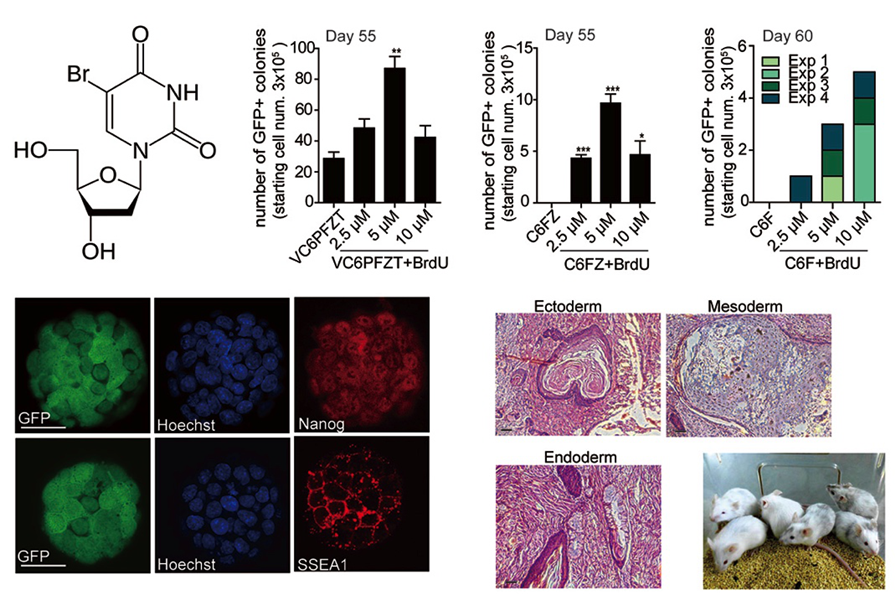

Direct reprogramming of somatic cells into induced pluripotent stem cells (iPSCs) with transcription factors (e.g., Oct4 (O), Sox2 (S), Klf4 (K), and c-Myc (M)) greatly expands our understanding of cell fate control. iPSCs resemble embryonic stem cells (ESCs) but without immune rejection and ethical issues, and are therefore considered as a promising source for cell replacement therapy. Patient-derived iPSCs could also be differentiated into disease-associated cell types and be used for drug screening. However, iPSC applications are hindered by safety concerns about the possible genetic alterations caused by the use of exogenous pluripotency-associated factors. Many efforts have been taken to make iPSCs more amendable in clinical applications by using non-integrating gene delivery approaches, or cell membrane-permeable proteins to induce the reprogramming.
Small-molecule compounds have also been found to be extremely useful in facilitating iPSC generation and can replace several reprogramming factors. However, complete chemical-mediated reprogramming of somatic cells into the pluripotent state has been proved to be extremely difficult. To date, only one study reported a seven- or four-chemical cocktail that can induce reprogramming. Here we report that the commonly used biological reagent, bromodeoxyuridine (BrdU), is able to enhance Yamanaka factor-mediated reprogramming. More interestingly, BrdU can replace Oct4, the most critical factor in iPSC generation. Further studies demonstrate that BrdU promotes full-chemical induction of mouse iPSCs using several chemical cocktails, with the minimal combination being BrdU, CHIR99021, Repsox, and Forskolin. These iPSCs resemble ESCs in terms of their gene expression, epigenetic status, in vivo differentiation potentials and the ability to generate chimera.

A research group headed by Professor Xie Xin of the Key Laboratory of Receptor Research, National Center for Drug Screening, Shanghai Institute of Materia Medica, Chinese Academy of Sciences, has established a 96-well plate-based screening system for chemicals that could affect OSKM-induced reprogramming of OG2 mouse embryonic fibroblasts (MEFs). Using this system we found that both LiCl and high osmotic pressure could enhance OSKM-mediated reprogramming of MEFs. Unexpectedly, we also discovered that BrdU, a synthetic nucleoside that is an analog of thymidine and is commonly used in tracing DNA replication, was able to facilitate OSKM-induced reprogramming. About 40 GFP+ colonies could be observed in BrdU-treated wells (starting from 4 000 MEFs/well), while only 1-2 colonies could be observed in the control well. We treated the OSKM-infected MEFs with BrdU for various durations starting from day 3, 6 or 9 post infections. BrdU displayed a remarkable effect at the early stage of reprogramming and showed the maximum effect if treatment was maintained from day 3 to day 7. BrdU could not maintain self-renewal of mESCs in LIF-free condition, and in the presence of LIF, BrdU even induced differentiation of mESCs. This explained why prolonged treatment of BrdU actually reduced the number of iPSC clones. Interestingly, the most effective concentration of BrdU in promoting reprogramming seems to vary according to the starting density of MEFs. The lower the starting MEF density is, the lower the most effective concentration of BrdU will be. BrdU not only increased the number of GFP+ cells, but also speeded up the reprogramming process. GFP+ cells could be observed in the BrdU-treated group as early as on day 7 by FACS analysis, and more than 30% of the cells were GFP+ on day 14 in the BrdU group.
The relevant result was published online at Cell Research on August 7, 2015, PhD student Long Yuan from the Laboratory is the first author.
Contact:
Xie Xin,
CAS Key Laboratory of Receptor Research, the National Center for Drug Screening, Shanghai Institute of Materia Medica, Chinese Academy of Sciences, Shanghai 201203, China
Tel: 86-21-50801313 ex 156
E-mail: xxie@simm.ac.cn